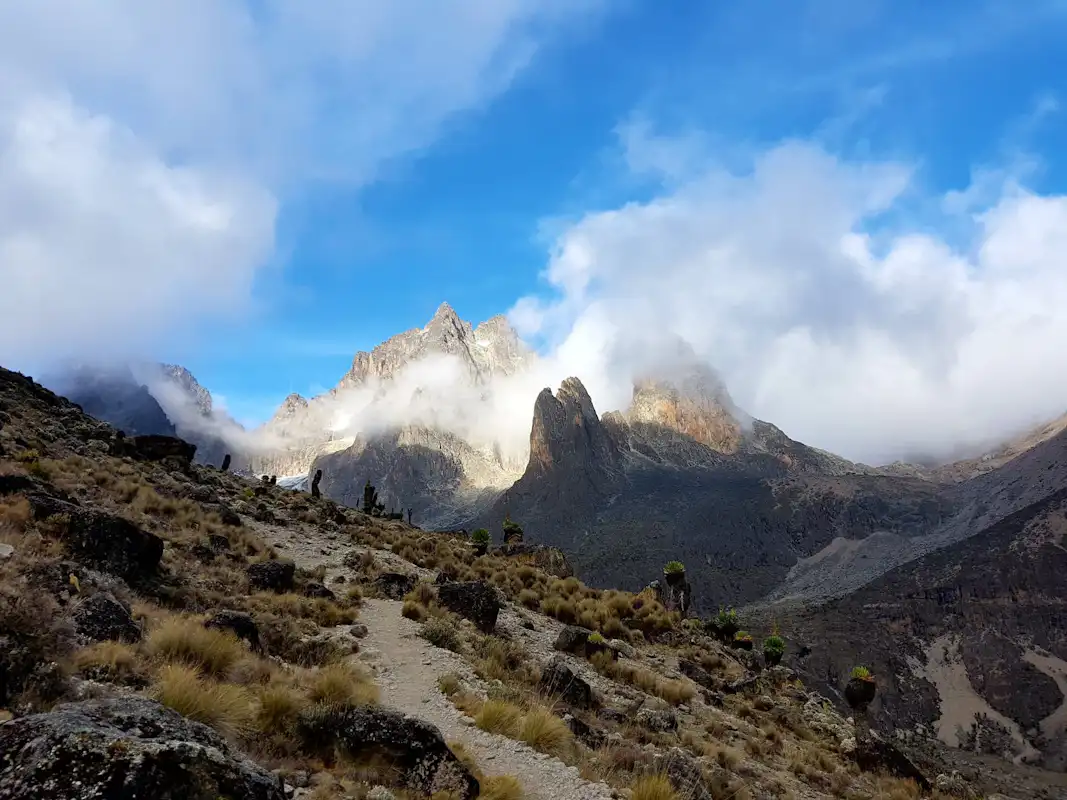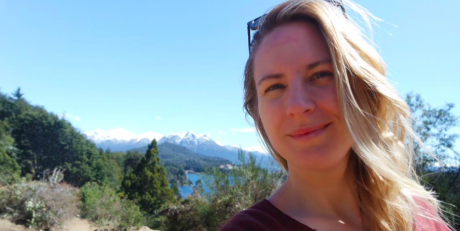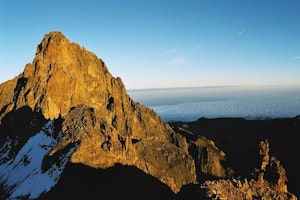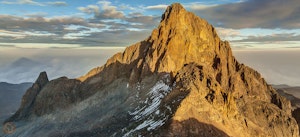If you’re planning an ascent of Mount Kenya, there are a few important things you need to know before you go.
If climbing Kenya's highest peak and the second tallest one on the African continent is not yet on your list of mountains to climb, it definitely should be.
Revered by Kenyan people, Mount Kenya is seen as a holy place. The country is even named after it, that’s how special it is!
When people think about climbing mountains in Africa, it’s often its slightly taller cousin, Kilimanjaro that comes to mind.
However, Mt Kenya is an important climb in its own right.
Rising to 5,199 meters (17,057 feet) in elevation, it’s only slightly lower than Kilimanjaro, yet it’s more cost-effective and provides a more off-the-beaten-path adventure.
How to get to Mount Kenya?
Mount Kenya is situated around 200 kilometers (125 miles) northeast of Nairobi.
You'll need to fly into Nairobi's international airport, Jomo Kenyatta (NBO). From the airport, the start point of the hike can be easily reached via the highway in a bus or private transport.
Most guides will opt to meet you at the airport, however, and provide transport tot he start fo the trip.
It’s a very accessible mountain but it’s important to tackle it with an experienced guide so that you approach the climb correctly.
You can still enjoy peace and solitude while climbing Mount Kenya. This is something that you won't necessarily find climbing Kilimanjaro due to the huge crowds it attracts.
From the summit, you get excellent panoramic views of the Kenyan plains and the other mountain peaks surrounding the Rift Valley.
A pre-dawn start is required on summit day, which means you’ll get to enjoy watching the sunrise over the savannah. If you’re really lucky, you may even get a glimpse of Kilimanjaro off in the distance.
The three summits of Mount Kenya
Mount Kenya actually has three peaks: Batian, Nelion and Point Lenana. Depending on which one you choose to climb, the ascent ranges from a intermediate-level trekking experience to a highly technical rock climb.
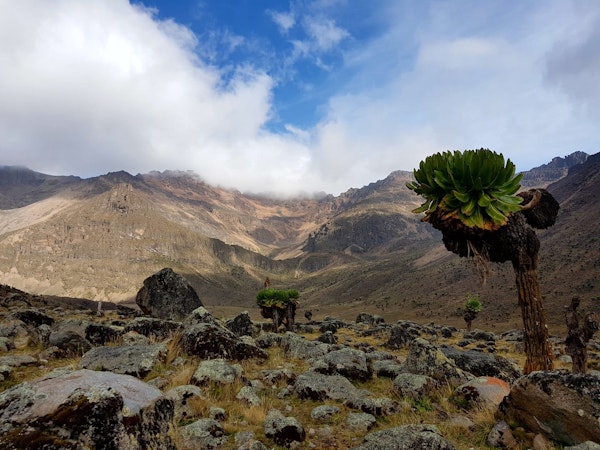
While many guides offer ascents of all three summits, there are also options to only hike to Point Lenana.
Batian
Batian is Mount Kenya's highest peak and rises to 5,199 meters (17,057 feet) in elevation.
It is the main summit of Mount Kenya and is a highly coveted goal for advanced rock climbing and mountaineering enthusiast.
After trekking up toward the peak, those planning to summit Mount Kenya's highest point will need to get out the technical climbing gear and ascend either the standard route on the north face, which is rated IV+ (note, this route is best taken from July to September).
The southwest ridge route, which is slightly easier is another option for climbers, with the best time to climb running from December to March.
Nelion
Slightly lower on the massif you’ll find Batian's slightly smaller twin peak of Nelion, at 5,188 meters (17,021 feet).
There is one main route that leads to the summit, which is known as the normal route. Rated as IV-, it serves as a good warm up for those attempting to summit Batian later in the morning.
This again is a challenging climb that requires experience with multi-pitch rock climbing to reach.
Point Lenana
The third peak and lowest summit on the Mount Kenya massif is Point Lenana, which rises up 4,985 meters (16,354 feet) in elevation.
This is the most popular peak for hikers as it does not require any technical climbing skills to reach**.** However, it is still a challenging ascent and requires a great deal of physical fitness to reach.
Many different routes and trails lead to this peak, many guides will mix and match them, depending on how much time you have, in order to see as much as possible on and around the mountain.
How hard is it to climb Mount Kenya?
Regardless of the summit to which you head on Mount Kenya, you will need a high level of fitness, as there are many steep sections. You’ll also need to hike considerable distances over multiple days.

Altitude can also make this ascent more difficult. This is where hiring a certified guide really is important, to make sure that you're not gaining altitude too quickly. Plus, if you do suffer from altitude sickness, you'll want an experienced guide on hand to help you manage this.
Embark on a 9-day journey to Lenana Peak in Mount Kenya, together with certified guide Xavi!
If you chose to tackle Batian or Nelion, it’s essential that you bring the right equipment too, since you cannot complete these climbs without rock climbing gear.
What are the main Mount Kenya climbing routes?
There are five main routes to reach point Lenana on Mount Kenya. It’s pretty common to combine these and to choose different trails for the ascent and descent.
This helps you control the time of your trip and it also means you get to see different scenery and experience the diverse landscapes surrounding the mountain.
If you wish to take on one of the two more technical summits, you will still first need to reach Point Lenana before carrying on.
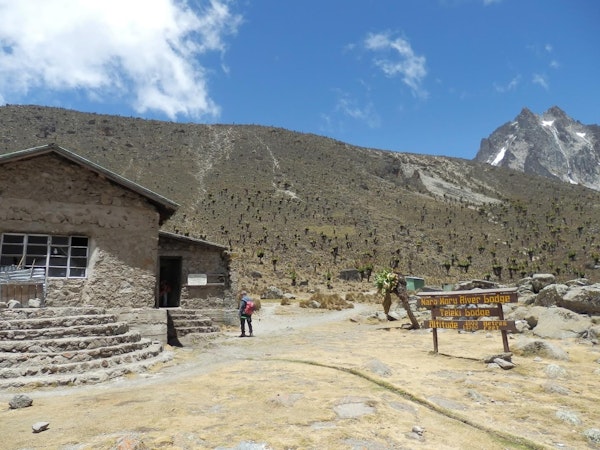
Sirimon
The Sirimon route allows you to ascend more steadily and gives you a stunning approach to the final peak.
For this route, you’ll need a minimum of two days but it’s better to take an extra day to really adjust to the altitude.
This is one of the most popular routes to the summit and there are a few good things about this route: one is that it’s somewhat protected from the rainfall so the track stays drier.
The other is that there are two camps along the way, Old Moses at 3,300 meters (10,800 feet) and Shipton’s camp 4,200 meters (13,800 feet). This allows you to recharge on your way up and take the walk at your own pace.
So what are you waiting for? Make your next incredible outdoor adventure an incredible 5-day ascent of Mount Kenya via the Sirimon route!
Burguret
This route is excellent if you want to really feel alone on the mountain. Plus, you get to hike through some tropical rainforest at the start of the hike.
You'll spend your night in wilderness huts. This is a challenging route as it’s used less often than others and there are times when you’ll have to hack your way through wild vegetation. It can also get pretty muddy.
On the upside, it’s a pretty special experience feeling alone as you hike up this majestic mountain. This trail takes a minimum of three nights and it’s ideal to combine it with a different trail for the descent.
Naro Moru
This trail is the shortest and most direct route. As such it is the most popular and tends to get quite busy.
The route is best suited for the descent (but also makes for a great ascent as well) as it’s relatively quick and easy. The plant life on offer on the way is also spectacular.
However, it has sections, such as the notorious Vertical Bog, which can get waterlogged.
This trail can be done in a long day but it's better across two days and one night.
Looking for your next off-the-beaten-path adventure? Look no further than this incredible 5-day ascent of Mount Kenya via the Naro Moru route!
Chogoria
The Chogoria route is another awesome option for your ascent and/or descent of Mount Kenya**.**
It takes a bit longer, so you’ll need more time, but is well worth it. The scenery is spectacular and you’ll be able to take in views of waterfalls and an amazing gorge.
This descent takes around three days.
Hesitate no longer! Take a more scenic approach to climbing Mount Kenya and book a 6-day traverse via the Chogoria route today!
Timau
This is an older track and is really not used much these days.
It’s not the best route as there is nowhere to stay overnight along the way nor are there any facilities.
South Ridge route to Nelion
If you want to go beyond Point Lenana, Nelion is the next highest peak.
The route to this summit takes you along the south face of the mountain and the views along the way are breathtaking.
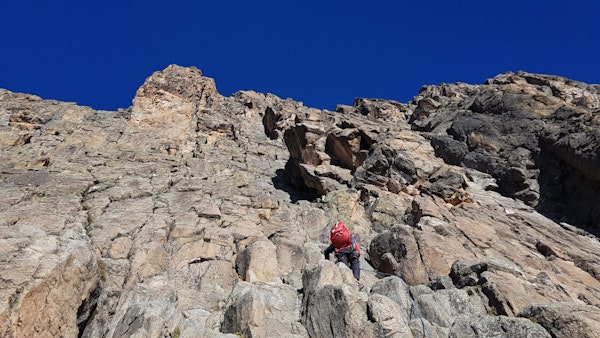
This route requires around eight hours of climbing with around 18 pitches. It's a heavily technical climb that requires previous experience.
The descent is then done in three hours the next day. If you want, you can also extend your climb by crossing over to Batian, the highest peak via what is known as the "Gates of Mist".
North face route to Batian
If you've not approached Batian already from Nelion, you can reach it via a climb on the north face of the mountain.
This is a more challenging climb and is for advanced climbers. It takes around 12 hours to ascend and then five to descend, which is done after a nights sleep on the mountain.
What is the weather like in Mount Kenya?
Mount Kenya has the typical climate associated with a mountain that sits directly on the equator: it is generally warm and sunny during the day with temperatures dropping substantially at night.
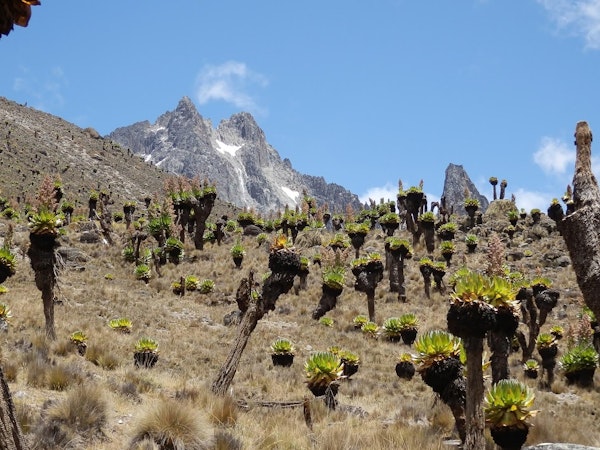
The dry season runs from December to March as well as July to September. These two windows are the best time to climb since there is very little precipitation. Expect average daily temperatures between 11 ºC to 26ºC (52 ºF to 79 ºF), depending on elevation.
In spite of its high altitude, temperatures at the summits rarely drop below freezing.
Before making the final ascent, you’ll be sleeping in high altitude camps and it gets very cold there. It’s important that you go prepared for these weather conditions.
That means bringing a suitable sleeping bag, thermal base layers, fleeces and protective outer layers.
How much does it cost to climb Mount Kenya with a guide?
The cost depends a lot on the duration of the climb. For a guided climb to Lenana Peak, you’re looking at a cost of around $2,000-$4,000 USD.
This cost generally includes food and accommodation, both in Nairobi and on Mount Kenya, as well as necessary technical equipment.
Remember, prices as well as what is included largely depend on the guid, so remember to always confirm both of these before booking your trip.

So, now that you know more about what it takes to reach the summit, it's time to make it happen. Check out our awesome options to climb with a certified guide. Then, you’ll be one step closer to taking on the mighty Mt. Kenya and enjoying exceptional views of the African savannah.
